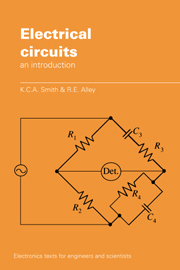Book contents
- Frontmatter
- Contents
- Program listings
- Preface
- 1 Basic concepts, units, and laws of circuit theory
- 2 Theorems and techniques of linear circuit analysis
- 3 Alternating current circuits
- 4 Power and transformers in single-phase circuits
- 5 Three-phase alternating current circuits
- 6 Transient and steady-state analysis
- 7 Non-linear circuit analysis
- 8 Two-port networks
- Appendices
- Bibliography
- Answers to problems
- Index
1 - Basic concepts, units, and laws of circuit theory
Published online by Cambridge University Press: 05 June 2012
- Frontmatter
- Contents
- Program listings
- Preface
- 1 Basic concepts, units, and laws of circuit theory
- 2 Theorems and techniques of linear circuit analysis
- 3 Alternating current circuits
- 4 Power and transformers in single-phase circuits
- 5 Three-phase alternating current circuits
- 6 Transient and steady-state analysis
- 7 Non-linear circuit analysis
- 8 Two-port networks
- Appendices
- Bibliography
- Answers to problems
- Index
Summary
Properties of the electrical circuit
An electrical circuit comprises an arrangement of elements for the conversion, transmission and storage of energy. Energy enters a circuit via one or more sources and leaves via one or more sinks. In the sources energy is converted from mechanical, thermal, chemical or electromagnetic form into electrical form; in the sinks the reverse process takes place. Sources and sinks are linked by elements capable of transmitting and storing electrical energy. The familiar battery-operated flashlamp serves as a reminder of the energy flow processes in a circuit. In this device, energy is converted from chemical to electrical form in the battery and transmitted along wires to the lamp where most of the energy is converted into heat. A small but useful portion is emitted in the form of electromagnetic radiation in the visible part of the spectrum.
In an electrical circuit energy is conveyed through the agency of electrical charge and through the medium of electric and magnetic fields. An essential feature of any circuit, therefore, is the provision of conducting paths for the conveyance of charge. As indicated in fig. 1.1, sources and sinks are operative only when charge flows through them. The rate at which charge flows is referred to as the current; the greater the current the greater the energy transmitted between sources and sinks.
Charge is set in motion by the action of the electric field established throughout the circuit by the sources.
Information
- Type
- Chapter
- Information
- Electrical CircuitsAn Introduction, pp. 1 - 41Publisher: Cambridge University PressPrint publication year: 1992
